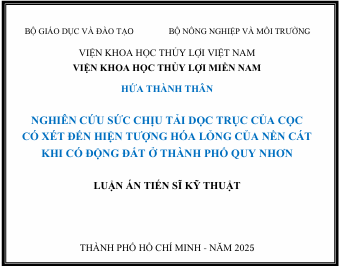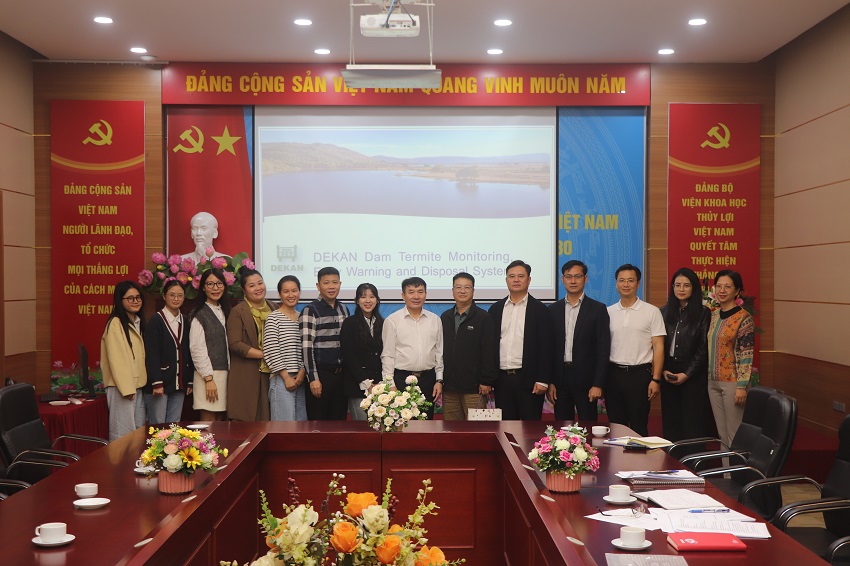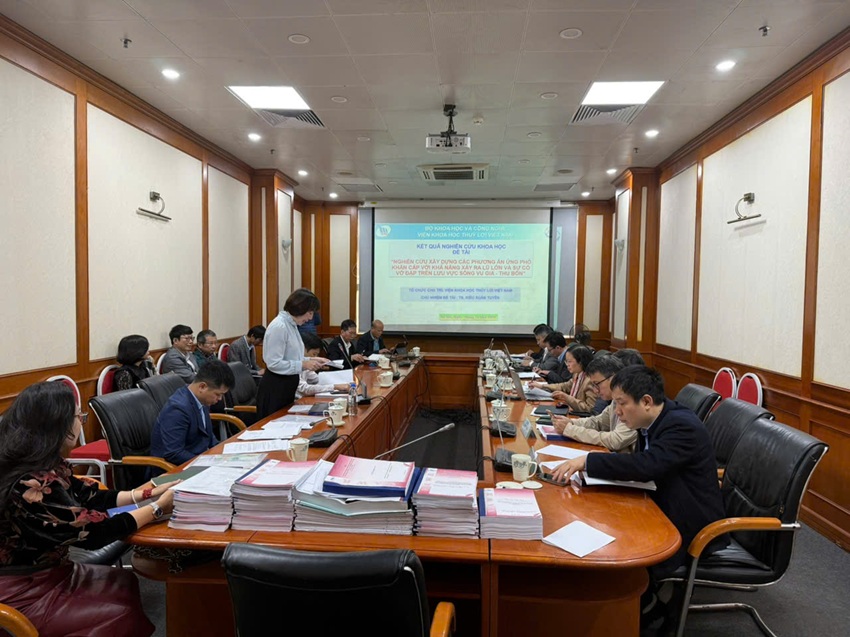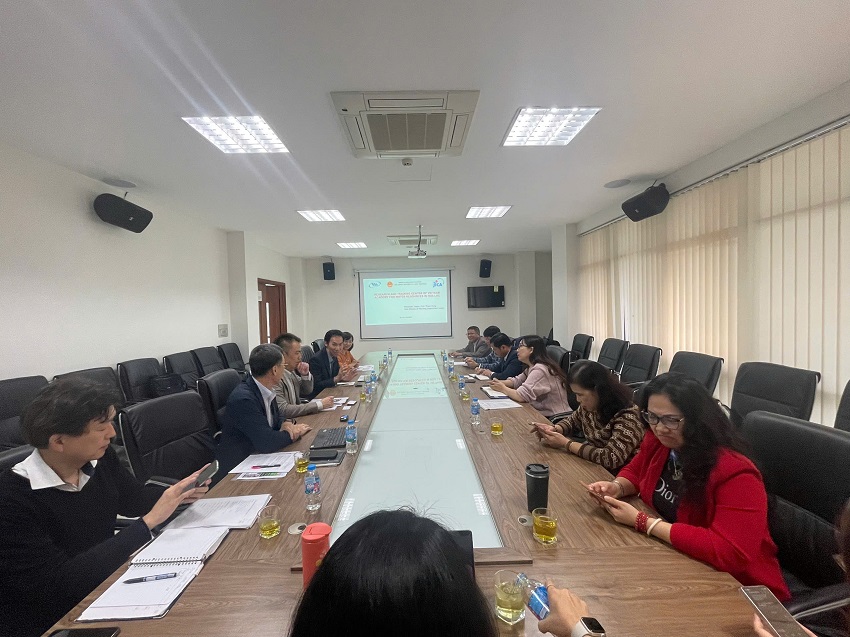Trích yếu luận án Tiến sỹ kỹ thuật của NCS. Nguyễn Anh Tú
15/04/2013Tên tác giả: Nguyễn Anh Tú. Tên Luận án: "Nghiên cứu giải pháp tường hào đất - bentonite - xi măng để nâng cao khả năng chống thấm cho đập đất". Chuyên ngành: Xây dựng công trình Thủy. Mã số: 62 58 40 01. Đơn vị đào tạo sau đại học: Viện Khoa học Thủy lợi Việt Nam
NỘI DUNG CỦA BẢN TRÍCH YẾU
Mục đích và đối tượng nghiên cứu của luận án:
- Đối tượng nghiên cứu:
+ Vật liệu Đ-B-X làm tường hào chống thấm cho đập đất;
+ Quá trình xâm nhập và hình thành màng vỏ sét của dung dịch bentonite vào vách hào
- Mục đích nghiên cứu:
+ Nghiên cứu lựa chọn thành phần cấp phối của hỗn hợp vật liệu Đ-B-X phù hợp để dùng làm tường hào chống thấm cho đập đất có hệ số thấm k≤1.10-6cm/s
+ Nghiên cứu quá trình xâm nhập, cũng như sự hình thành màng vỏ sét (filter cake) của dung dịch bentonite vào đất, cát sỏi có độ rỗng khác nhau
+ Nghiên cứu khả năng chống thấm của mẫu đất sau khi dung dịch bentonite xâm nhập vào vách hào, từ đó đề xuất cần phải bổ sung thêm phần đất được bentonite xâm nhập trong quá trình tính toán thấm và ổn định của đập
- Phạm vi nghiên cứu:
+ Áp lực dung dịch bentonite thí nghiệm trong luận án này có H≤6m, chiều dài xâm nhập lớn nhất là 80cm.
+ Đất có hàm lượng sét thấp, có hệ số thấm lớn (K=10-4cm/s)
Các phương pháp nghiên cứu đă sử dụng:
- Phương pháp phân tích tổng hợp: Qua nghiên cứu tài liệu trong và ngoài nước về các vấn đề có liên quan, tổng kết các kinh nghiệm thu được từ các dự án thực tế đã sử dụng vật liệu bentonite tại Việt Nam...
- Nghiên cứu thực nghiệm: Sử dụng phương pháp đo đạc thực nghiệm (trong pḥòng, ngoài hiện trường) để xác định các tính chất và chỉ tiêu cơ lý của vật liệu Đ-B-X, quá trình xâm nhập của dung dịch bentonite vào trong đất và tầng cuội sỏi.
- Nghiên cứu bằng mô hình vật lý: thông qua mô hình vật lý nghiên cứu ứng xử của tường hào theo thời gian. Khả năng co ngót, xuất hiện vết nứt của tường hào trong quá trình làm việc
- Nghiên cứu bằng mô hình số: sử dụng phương pháp phần tử hữu hạn để phân tích đánh giá ảnh hưởng của lớp vỏ sét đến lưu lượng. hệ số thấm. đường bão hoà trong thân đập
Các kết quả chính và kết luận:
- Ý nghĩa thực tiễn:
+ Các kết quả nghiên cứu Luận án đạt được phục vụ trực tiếp cho công tác tính toán thấm và ổn định đập đất. Các cấp phối vật liệu tường hào chống thấm Đ-B-X Luận án đưa ra có thể sử dụng trong công tác xử lư chống thấm cho các công trình có dấu hiệu mất ổn định thấm, cũng có thể sử dụng trong các công trình xây mới cần bố trí tường hào chống thấm do vật liệu đắp đập có hệ số thấm lớn, khu vực xây dựng công trình hiếm vật liệu chống thấm
+ Bên cạnh khả năng chống thấm, hỗn hợp được nghiên cứu do có khả năng chống cắt lớn có thể được sử dụng để sữa chữa nâng cấp, nâng cao độ ổn định của các công trình đập, đê cũ.
+ Đưa ra được giải pháp chống mất vữa dung dịch bentonite khi thi công tường hào bentonite gặp tầng cuội sỏi.
- Ý nghĩa khoa học:
+ Khẳng định được công nghệ tường hào chống thấm đập đất Đ-B-X là một giải pháp không những hiệu quả về mặt kinh tế (giảm 23,3% giá thành vật liệu sử dụng so với công nghệ tường hào X-B đă sử dụng ở Việt Nam) mà còn đạt được nhiều thành công về mặt kỹ thuật khi áp dụng vào thực tế (khả năng chống thấm của vật liệu tường hào tăng; tận dụng được nguồn vật liệu đất đào hào …).
+ Khẳng định được dung dịch bentonite ngoài tác dụng ổn định chống sập thành vách hố đào còn có tác dụng nâng cao khả năng chống thấm cho vùng đất được dung dịch bentonite xâm nhập. Từ đó tác giả đề xuất cần thiết phải bổ sung thêm vùng đất có bentonite xâm nhập và màng vỏ sét trong quá tŕnh tính toán ổn định.
+ Đã chỉ ra được ảnh hưởng của xi măng đối với việc nâng cao cường độ chống cắt đồng thời cũng làm tăng hệ số thấm của hỗn hợp đất-xi măng- bentonite.
- Kết quả của luận án:
1. Luận án đã tìm được mối quan hệ giữa quá trình xâm nhập của dung dịch bentonite vào vách hào với các độ rỗng của đất khác nhau 41%, 43%, 45%. Hệ số thấm của đất sau khi có dung dịch bentonite xâm nhập giảm khoảng 10 lần so với đất nguyên trạng.
2. Luận án đă nghiên cứu và đưa ra giải pháp chống mất dung dịch bentonite trong trường hợp đào hào gặp tầng cuội sỏi có độ rỗng n<50% bằng cách trộn thêm cát mịn có tỉ lệ đến 10% vào trong dung dịch bentonite.
3. Luận án đã nghiên cứu và đề xuất được cấp phối vật liệu Đ-B-X với hàm lượng 62% đất khô, 4% bentonite, 3% xi măng và 31% nước để làm tường hào chống thấm. Hệ số thấm đạt được k≤1.10-6cm/s với điều kiện thi công thực tế ở Việt Nam, đồng thời đạt được hiệu quả kinh tế - kỹ thuật.
4. Qua tính toán bằng phần mềm SEEP/W, đập được xét với cả ba yếu tố tường hào, vùng đất được bentonite xâm nhập và màng vỏ sét có khả năng chống thấm và ổn định lớn hơn khi chỉ kể đến tường hào. Lưu lượng thấm đơn vị giảm 26,57% và hệ số ổn định tăng từ Kminmin = 1,110 đến Kminmin = 1,181 so với khi chỉ kể đến tường hào.
.
TÓM TẮT NHỮNG ĐÓNG GÓP MỚI CỦA LUẬN ÁN
1. Ngoài tác dụng ổn định thành vách hố đào, dung dịch bentonite c̣òn làm tăng khả năng chống thấm vùng đất được bentonite xâm nhập. Hệ số thấm của đất sau khi có dung dịch bentonite xâm nhập giảm khoảng 10 lần so với đất nguyên trạng. Từ đó tác giả đề xuất cần thiết phải bổ sung thêm vùng đất có bentonite xâm nhập và màng vỏ sét trong quá trình tính toán ổn định.
2. Đề xuất được giải pháp chống mất vữa dung dịch bentonite trong trường hợp gặp tầng cuội sỏi bằng cách pha cát mịn vào dung dịch bentonite với tỷ lệ 10% khi gặp tầng cuội sỏi có độ rỗng <50%.
3. Đề xuất được cấp phối vật liệu Đ-B-X hợp lý để làm tường hào có hệ số thấm k≤1.10-6 cm/s phù hợp với điều kiện thi công thực tế ở Việt Nam, điều đó mang lại hiệu quả kinh tế - kỹ thuật
PhD Thesis abstract a) Introduction: Name of author: Nguyễn Anh Tú Thesis title: Study on soil – bentonite - cement cut-off wall for improvement of seepage control in earth dams Principle of thesis: Construction of Hydraulic works; Code: 62 - 58 - 40 - 01 Name of training unit: Vietnam Academy of Water Resources Research b) Content: Thesis objectives and subjects: - Study subjects: + Soil – Bentonite – Cement materials for cut-off walls in earth dams; + Process of penetrating and filter cake formation at the slurry wall. - Study objectives: + Study to determine appropriate aggregation of soil-bentonite-cement mixtures to use for cut-off wall in earth dams with seepage coefficient k≤1.10-6 cm/s. + Study the process of penetrating and filter cake formation at the slurry wall in soils, rocks and gravels with different void ratios. + Study the anti-seepage capacity of soil samples with bentonite slurry penetrated then recommending if bentonite-penetrated soil should be added in the process of calculating for seepage control and stability of dams. - Scope of study: + Pressure of bentonite slurry in tests in this study has the height, H≤6m, and the maximum penetrated length is 80cm. + Soils with low clay content, high seepage coefficient: (K>=10-4cm/s) Applied study methods: - Synthetic method: Studying domestic and international materials and references in related subjects, summarized and learning lessons from projects actually applied bentonite materials in Vietnam, etc. - Experiment study: Applying the experiment, measuring method (in the laboratories, on field) for determining properties and mechanic-physic properties of soil-bentonite-cement materials, penetration process of bentonite slurry in soils and gravel layers. - Physical modeling: Using the physical model to study behaviors of cut-off wall in time, possibility of shrinkage, crack of cutoff wall at work. - Numerical modeling: Using the finite element method to analyze impacts by filter cake to flow, seepage coefficient, and top flow line in dam body. Key outcomes and conclusions: - Practical significance: + The outcomes of the study shall be applied practically in calculating the seepage control and stability of earth dams. The aggregations of soil-bentonite-cement materials for cutoff walls recommended by this study can be used in seepage control works in any project where they have any evidence of seepage-based instability, or can be used in new construction works that need cutoff walls due to high permeability of embankment materials and lack of low permeability materials for seepage control + In addition to the seepage control capacity, the studied mixture has high shear strength, so it can be used for repairing, upgrading and improving the stability of existing dams, dikes, etc. + The study introduces methods to minimize the loss of bentonite soil solution while the construction of trench encounters with a gravel layer. - Scientific significance: + Confirming that the technology of seepage control for earth dams with soil-bentonite-cement cutoff walls is not only a cost-saving solution (reducing 23.3% of cost for materials compared with the cement-bentonite cutoff wall method that is being applied in Vietnam), but also an achievement in applied technical aspect in the current practice (increased capacity of seepage control in cutoff wall materials; making use of soil excavated for cutoff walls, etc.) + Confirming that the bentonite slurry not only works on stabilization of trench wall during construction but also helps increase anti-seepage capacity for the area of soils where bentonite slurry has penetrated in. Then, the author recommends that it is necessary to enlarge the area of soils where bentonite can be penetrated and the filter cakes for stability analysis. + Pointed out the impacts of cement on improvement of shear strength, meanwhile, increase of seepage coefficient of soil – cement – bentonite mixture. - Thesis outcomes: 1. The Thesis has studied and found out the relations between the penetration processes of bentonite solution into cut-walls responding to different void ratios of soils, in range of 41%, 43%, 45%. The seepage coefficient of soil measured when the soil has been penetrated by bentonite reduces approximately 10 times compared with the soil in primitive status. 2. The Thesis has studied and recommended the solution for minimizing bentonite slurry lost in case the slurry trench encounters with a gravel layer with void n<50% by adding fine sand up to 10% into the bentonite slurry. 3. The Thesis has studied and recommended the aggregation of soil-betonite-cement materials with the proportion: 62% of soil, 4% of bentonite, 3% of cement and 31% of water for making cut-off walls. The seepage coefficient attained is k≤1.10-6cm/s in current construction conditions in Vietnam, meanwhile, the cost-saving and technical efficiency are also ensured. 4. Using SEEP/W software for seepage and stability analysis, the dam that is considered with all 3 factors: cut-off wall, bentonite penetrated soil area, and filter-cake will have higher capacity for seepage control and higher stability compared with the case of only 1 factor, i.e. cut-off wall. Seepage discharge reduces 26.57% and the safety factor increases from Kminmin = 1.110 to Kminmin = 1.181 compared with the case of only 1 factor, i.e. cut-off wall. Summary of achievements of the thesis 1. In addition to the effectiveness as stabilizing the cut-walls, bentonite solution increases the capacity of seepage control in the area where soil is penetrated by bentonite. The seepage coefficient of soil measured when the soil has been penetrated by bentonite reduces approximately 10 times compared with the soil in primitive status, therefore, the author recommends including the area of bentonite-penetrated soil and filter-cake in the process of stability calculation. 2. It is recommended that the solution for minimizing bentonite slurry lost in case the cut-wall encounters with a gravel layer with void ratio n<50% is to add fine sand up to 10% into the bentonite solution. 3. It is recommended appropriate proportion of soil-bentonite-cement materials for making cut-off walls with the seepage coefficient k≤1.10-6cm/s in current construction conditions in Vietnam, and thus this is really a cost-saving and technically efficient.
Ý kiến góp ý:











